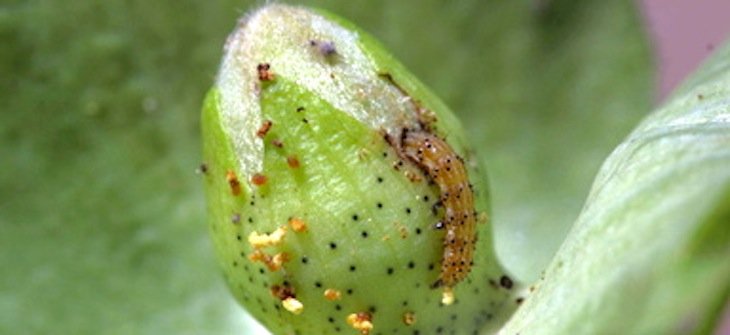Arkansas farmers experiencing bollworm explosion
by July 6, 2022 12:48 pm 2,418 views

The numbers of a common, damaging pest in Arkansas row crops have surged in the last several weeks.
Bollworms, a moth caterpillar, are typically found in cotton, soybean and corn crops. The insect emerges as a moth in mid-May and then spreads its larva onto crops, according to farmprogress.com. Hungry bollworms can damage soybean pods, corn ears and cotton bolls and squares.
Yields can be diminished as a result of bollworm damage.
Surveillance done by Cooperative Extension Service County agents around the state has found bollworm numbers up significantly when compared to 2021. Each year, agents post traps, and each month, they count the trapped insects as an indicator of what pests local farmers might expect to see in their fields.
“These bollworm numbers have exploded it seems in the past two or three weeks,” said John David Farabough, Desha County extension agent for the University of Arkansas System Division of Agriculture. “I have traps spread from north to south borders in Desha County and all are running high numbers for this time of year.”
“Normally, at this time of year, I’m running 100 to 200 moths per trap per week,” he said. ”Now, weekly trap counts are running 500 to 800 moths per trap per week.”
Farabough said he typically doesn’t see these numbers until late July or early August “when the corn in the area is drying out and then moths move into soybeans.”
“We are experiencing a pretty big bollworm flight. It does appear to be higher trap catches than what we were seeing at this time last year,” said Glenn Studebaker, extension entomologist and integrated pest management coordinator for the Division of Agriculture.
“We are seeing them primarily in soybean and grain sorghum right now, but I expect we will begin to see significant populations in cotton as well,” he said. “Growers need to be diligent in scouting susceptible crops for bollworm at this time.”
Studebaker said some areas are seeing more than 2,000 moths per seven-day catch.
“Reports are coming in of bollworms being found in flowering soybeans,” he said. “Some are picking up six to eight worms per 25 sweep samples in R2 soybeans.”
R2 is a reproductive stage at which soybeans are in full flower.
“Growers are encouraged to keep watch for bollworm larvae in susceptible crops such as soybean, grain sorghum or cotton,” Studebaker said. “It is likely with such high moth catches that we will see increased numbers in these crops.”
Insecticides can be used to control bollworm populations, but it can be costly for farmers and it can cause other issues. Bollworm populations can be controlled to a degree by natural predators, but insecticides can impact this natural control.
Maintaining water levels in crops can also help to stem the number of bollworms, but recent hot and dry weather throughout the Arkansas Delta can make this more problematic.
Parts or all of four counties in northern Arkansas – Fulton, Sharp, Randolph and Clay – have been classified as in stage one drought by the National Weather Service. Virtually every other county in the Delta, including Craighead, Crittenden Greene, Lawrence, Mississippi and Poinsett counties are classified in the abnormally dry range, according to NWS.
Little rain is projected to fall in the region during the next week.
